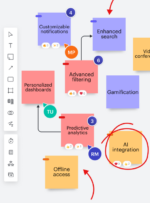
Have you ever tried to explain to someone new to your hometown how to get to your favorite restaurant? Doing that verbatim is quite challenging, using a map helps you point to and show what you are talking about. You can point to where to make that left turn, after the right turn at the traffic light. It lets others understand where they are relative to their overall journey and ask for clarification and feedback. It streamlines communications and helps you plan and communicate on how to get where you want to be.
RELATED CONTENT:
Gently down the value stream
How does your solution help organizations on their value stream journey?
A guide to VSM tools
Losing command and control…and living with it!
So how do you do that?
Start simple. Pick one, non-complex development process and draw it out on a whiteboard. Define the phases of the value stream and the three or four gates that mark tasks all along the way from the starting point, to middle steps and to the finish. It’s good to note that in software development, each gate can be a small pipeline of substeps that need to be completed before the gate itself is complete and value can be moved downstream.
Managing your value streams lets you focus on delivering value to the customer. To do this, you need to connect multiple teams, tools and applications to gain clear visibility and insight into how the value flows through the software delivery process. This also means having a way to access metrics on DevOps performance across the teams, and tracking throughput and stability related to product releases. The goal is to deliver quality software at the speed that your customers want it, in order to drive value back to the organization.





